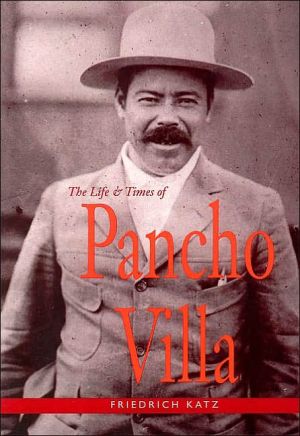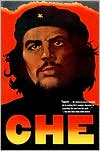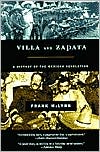The Life and Times of Pancho Villa
“The lifework of a great historian, this book is without rival as a biography of one of the enigmatic figures of the 20th century. . . . With scrupulous detail and objectivity, and with a fluid narrative style, this is the book on Villa that has long been awaited by both scholars and general readers.”—Adolfo Gilly, Universidad Nacional Autónoma de Mexico\ “Friedrich Katz’s The Life and Times of Pancho Villa is a masterpiece of contemporary historiography. . . . Diligent, extremely...
Search in google:
A “Best Book of 1998” Library Journal selection“This is the definitive work on Mexican revolutionary Pancho Villa. . . . The work is exhaustively researched and scrupulously documented; it also makes for engrossing reading, as Latin America specialist Katz takes hold of the legend, gives it a good shaking, and comes up with something far more complex.”—Library Journal starred review“A splendid work that can be enjoyed by the general reader and by scholars of the period on both sides of the border.” —The Journal of American History Library Journal There's no doubt about it--at just over a thousand pages, this is the definitive work on Mexican revolutionary Pancho Villa, who has heretofore not received the attention granted fellow revolutionaries from Lenin to Che. Yet while the work is exhaustively researched and scrupulously documented, it also makes for engrossing reading, as Latin America specialist Katz takes hold of the legend, gives it a good shaking, and comes up with something far more complex. (LJ 1/99)
\ \ \ \ \ Chapter One\ \ \ From the Frontier to the Border\ \ \ There is enormous animosity against the hacienda for which I have no explanation, and which would have seemed incredible to me, if I did not feel it every moment. Many of the servants whom we considered loyal have greatly disappointed us; they have been captivated by the promises made by the revolutionaries that the lands would be divided among them, and right now all they think about is the realization of such a beautiful dream. Many of them have received great benefits from the hacienda and they are the ones who demand land with the greatest eagerness, not because we have caused them any harm, but because of their desire for their own profit.\ —The administrator of the hacienda\ of Santa Catalina to its owner\ \ \ \ On the eve of the Spanish Conquest, what is today the state of Chihuahua had been part neither of the Aztec empire nor of the complex civilization known as Mesoamerica, which included the inhabitants of central and southern Mexico. In contrast to Mesoamerica, Chihuahua had no large cities, no dense population living on intensive agriculture, and no highly stratified social groups. Instead, it was thinly populated by groups of hunters, gatherers, and some agriculturists, loosely organized into different tribes. The Aztecs had shown no interest in conquering this nomadic population, to which they collectively referred in the most derisive way as chichimecas, the sons of dogs.\ The Aztecs' lack of interest is not surprising. The vast stateof Chihuahua consists mostly of deserts and inhospitable mountain ranges. Large parts of central Chihuahua are taken up by the sand dunes of Samalayuca, while the even more arid Bolsón de Mapimi is located in the southeastern part of the state. The huge Sierra Madre, in western Chihuahua, are mostly just as inhospitable. Agriculture could be practiced only in limited regions, irrigated by rivers and lakes, mainly in the northwestern part of the state and to a lesser degree in eastern Chihuahua near the Conchos River. Some of the most important resources of Chihuahua were of no interest to the Aztecs. There were no cattle to graze on the fertile pastureland in the central part of the state, and the Aztecs lacked the technology to extract its rich mineral ores. They had no use either for its huge timber resources.\ Initially, the Spaniards, too, showed little interest in the region. Their attitude changed at the end of the sixteenth and the beginning of the seventeenth centuries, when large silver mines were discovered near the present cities of Chihuahua and Parral. Spanish settlements were soon established, and haciendas sprang up around them to supply the miners with food and to profit from the mining boom. Since it was difficult to attract laborers or immigrants from central Mexico or from Spain to this vast, undeveloped, and dangerous region, the Spaniards attempted to enslave the local population, most of whom were Tarahumara, whose way of life was predominantly nomadic. When Indian slavery proved to be both unsuccessful (many slaves fled into the Sierra Madre) and illegal (the Spanish Crown soon banned Indian slavery), new methods of influencing the Indians were attempted.\ The Jesuits and Franciscans tried to settle them in missions. Although temporarily subdued, the Tarahumara staged a number of uprisings, however, and the majority of them finally faded into the Sierra Madre, where the Spaniards had great difficulty in locating them, and where they resumed their nomadic way of life.\ Until the middle of the eighteenth century, the population of Chihuahua gradually expanded as more mines were developed, new haciendas were set up, and migrants decided to settle there. That expansion abruptly halted in the mid eighteenth century, when Apache raiders began to make their presence felt in Chihuahua. Until then, the Apaches had lived far to the north of Chihuahua, but in the eighteenth century, they were pushed southward by the far more powerful Comanches, and they began raiding Spanish settlements. The few hundred soldiers that Spain had stationed on the frontier were unable to put up an effective resistance, and many of Spain's hacendados as well as its miners fled southward or into a few large towns.\ Faced with the possible loss of this potentially rich province, the Spanish crown decided to set up a series of fortified settlements inhabited by armed peasant freeholders. Extraordinary benefits were given to migrants from Spain and from central Mexico, as well as to local Indians, who were willing to settle in these military colonies. They were granted large amounts of land and exempted from paying taxes for ten years. Indian military colonists, in contrast to the Indian peasants of central Mexico, who were considered wards of the crown, were given full rights of Spanish citizenship.\ By the end of the eighteenth century, these colonists began to be a fighting force able effectively to resist the Apache raiders. When the crown held out not only a stick in the shape of these military colonies but a carrot as well, offering to supply all Apaches who settled near Spanish towns with food, clothing, and alcohol, many of the nomadic raiders settled down. Although it was never completely pacified, the region was more peaceful than ever before. For the first time, the peasant freeholders were able to fully enjoy the fruits of their land and labor, for which they gave credit to the Spanish crown. As a result, when the Mexican war of independence broke out in 1810, not only did the military colonists along New Spain's northern frontier not join the revolutionaries in central and southern Mexico, but many of them decided to fight on the side of Spain.\ A century later, in 1910, after the Mexican government had again pacified the frontier, the descendants of these military colonists took a completely different attitude and fought in the forefront of the Mexican Revolution. The reason for that change in attitude can be found in the development of Chihuahua in the nineteenth century.\ The peace the Spanish crown brought to the frontier did not survive Spanish colonial rule. By 1830, the Apaches were raiding again. Weak Mexican governments, generally toppled after one or two years by military coups or by rival political factions, had neither the means nor the will to fight the Apaches. The payments in food and in kind that had kept them peaceful were canceled just as the Apaches began to sense the military weakness of the new Mexican government. The Mexican army was far more adept at staging coups in Mexico City than at fighting Apache raiders. Attacks on haciendas increased to such a degree that by the mid nineteenth century, most hacendados had abandoned their estates. By contrast, the military colonists stayed and fought, since they had nowhere else to go.\ Describing this period, the inhabitants of the old military colony of Namiquipa proudly wrote in a petition they drafted at the end of the nineteenth century, "all neighboring haciendas had been abandoned because of the constant danger of aggression by the barbarians between 1832 and 1860 and only Namiquipa remained to fight the barbarians and to constitute a lonely bastion of civilization in this remote region." This was true not only of Namiquipa but of many other military colonies and free villages in large parts of Chihuahua. In these years, they created what was in many respects a unique kind of society in Mexico, limited to northern Chihuahua and a few other regions that were prey to Apache attacks. It was a society that embodied a unique combination of savagery and democracy. Savagery was characteristic of both sides in the conflict. The Apaches frequently killed and tortured their prisoners, including women and children, and the Mexican authorities offered bounties for Apache scalps, also including those of women and children. The savagery at times extended to Tarahumara Indians, who did not raid Mexican settlements but frequently lost their lands and their properties to white and mestizo settlers.\ On the other hand, this Chihuahuan society of free rancheros perhaps most closely corresponded to the kind of U.S. frontier society painted in vivid colors by Frederick Jackson Turner. His hypothesis, which captured the minds of generations of Americans, was that the U.S. frontier created a unique kind of self-reliant, autonomous, independent farmer. These farmers, according to Turner, were unencumbered by the class differences and power structures of the eastern United States. The state was weak, the traditional wealthy families did not go west, and so a kind of egalitarian, self-reliant society was created in the west of the United States, which largely shaped the mentality of that country.\ In recent years, this hypothesis has aroused much controversy in U.S. historiography. Some historians argue that land speculators, wealthy landowners, and bankers were very much present in the settlement of what is generally considered the U.S. frontier—as was the state in the shape of the U.S. Army. In much of Chihuahua and some other parts of northern Mexico, the contrary was the case in the period from about 1830 to the 1860s. The state, which in the shape of Spanish colonial authorities, the army, wealthy landowners, and the Catholic church had been present at the genesis of the northern Mexican frontier in the sixteenth, seventeenth, and eighteenth centuries, had largely disappeared in northwestern Chihuahua by the 1830s. Many of the missions that the Jesuits had established vanished toward the end of the colonial period after the order was expelled from New Spain in 1767; the remaining missions were largely abandoned when Spanish rule ended in Mexico in 1821. Wealthy miners and hacendados fled as the Apaches advanced, and bankers and land speculators saw no value in lands that were constantly prey to nomadic attacks. The Mexican federal government and the federal army were far too weak and riven by internal dissension to have any significant presence in Chihuahua and northern Mexico, so the free rancheros were left to their own devices. The society they developed was poor but largely egalitarian. Chihuahuans were self-reliant and self-confident, with a fierce sense of pride in being able to maintain themselves in the face of such adversity. From the 1860s onward, that society would once again be transformed by the return of both the state and the hacendados to Chihuahua. The man who did most to engineer that return was one of the state's most important, flamboyant, and memorable figures, Luis Terrazas.\ \ \ The Rise of Luis Terrazas\ \ \ In the 1860s, after Mexico defeated the French invaders and put an end to Maximilian's empire, a more stable administration was established. Fearing that Chihuahua would be annexed by the United States if it was not brought firmly under Mexican control, the central government did everything in its power to fight the Apaches. New military colonies were established; settlers were given land if they were ready to fight against the Indian raiders; and, above all, the hacendados were induced to return. The man who was largely responsible for this new policy was Luis Terrazas.\ The son of a well-to-do butcher, Terrazas did not come from one of Chihuahua's ruling families, although he soon married into one of them. He joined the Liberal party in Chihuahua, became one of its leaders, and, in the course of the civil wars between Liberals and Conservatives, became Liberal governor of the state in 1859. Being more adept than his predecessors at fighting off the Apache raiders, he quickly became popular.\ Terrazas's organizational talents were not the sole reason for his success. His chief innovation was to divert tax revenues earmarked for the federal government in Mexico City to setting up militias to fight the Indians. While this approach was unpopular in Mexico's capital, it gained Terrazas prestige and support among many segments of Chihuahua's population, including its military colonists, who regarded the central authorities as useless exploiters and parasites.\ Terrazas did not devote all of his energies to fighting the Apaches. He also used the governorship to acquire some of the largest haciendas in the state. He acquired his largest estate by expropriating the property of another hacendado, Pablo Martinez del Río, who had the misfortune to choose the wrong side in the war between the French and Mexico. He obtained other estates by buying them cheap from hacendados who had abandoned them and saw no way of settling them again. Since he was governor of the state, Terrazas controlled the militia and was able to attract many laborers who had fled the countryside to work on his estates, because he was able to offer them a greater degree of protection than other hacendados. There is no evidence that when he began forming his empire in the 1860s, Terrazas expropriated any of the lands of the peasant freeholders in the military colonies. There were sufficient abandoned estate lands to meet his ambitions, and he needed the fighting power of the military colonists. While Terrazas was governor of the state, his cousin Joaquin Terrazas commanded militia units composed of peasant freeholders who were far more effective in fighting the Apaches than the few federal troops stationed in Chihuahua. The activities of this cousin reflected to the credit of Terrazas, and he gained a large measure of popularity in his native state.\ In 1876, the situations of Terrazas and of Mexico profoundly changed when General Porfirio Díaz, one of the heroes of Mexico's struggle for independence against Napoleon III, carried out a successful military coup and assumed power in Mexico. It was the beginning of the longest dictatorship in the history of Mexico. With the exception of four years from 1880 to 1884 when an ally of Díaz's, Manuel González, assumed the country's presidency, Díaz would rule Mexico until 1911, when he was overthrown by a popular uprising. In many respects, the Díaz regime met the fondest hopes of Mexico's wealthiest men, such as Luis Terrazas.\ In economic terms, Mexico underwent unprecedented economic growth. Newly constructed railroads linked Mexico to the United States, as well as to port cities in Mexico. The result was a tremendous increase in foreign investment in Mexico, as well as spectacular economic growth. Between 1884 and 1900, about $1,200,000,000 worth of foreign investment flooded into the country, and the gross national product rose at an annual rate of 8 percent. Mexico now enjoyed an unprecedented era of political stability. Uprisings by members of the elite and the military, which had been the hallmark of Mexico's history since independence, practically ceased. This was owing not only to the power of the state, whose revenues increased significantly thanks to economic growth and foreign investment, but also to the fact that members of the elite became intermediaries for foreign investors and thus had a major stake in maintaining the political stability that was a precondition for foreign investment. The increasing power of the state and the existence of railroads that greatly increased the mobility of government military forces allowed the regime to crush popular and middle-class uprisings wherever they occurred. Possibilities of political instability were drastically reduced by falsified elections, which led to a rubber-stamp congress that Díaz completely controlled. The result of political growth and economic stability was that Mexico's upper class were now able to accumulate enormous wealth. They did so not only by becoming intermediaries for foreign investors but also because they were able, thanks to the communication revolution that had taken place in Mexico, to export large amounts of goods both to the United States and to Europe. Díaz's policies of keeping down popular protest, muzzling the opposition press, preventing the formation of labor unions, and not allowing strikes greatly contributed to this enrichment. So did another of Porfirio Díaz's policies: large-scale expropriation of land that belonged to village communities.\ Unlike other members of Mexico's ruling class, Luis Terrazas by no means found Díaz's assumption of power an unmitigated blessing. In 1876, his political acumen had failed him, and instead of siding with Díaz, he had supported his rival, President Sebastián Lerdo de Tejada. As a result supporters of Terrazas were ousted from the governorship of Chihuahua, which was now occupied by a powerful rival of Terrazas's, Angel Trias. Terrazas thus suffered a setback, but it was by no means a decisive defeat. Díaz's policy was not to kill or exterminate members of the elite who had opposed him, but to remove them from power, allowing them to enrich themselves by all means at their disposal in the hope that they would thus be dissuaded from engaging in costly and destabilizing uprisings. Thanks to the newly built railroads, Terrazas was able to export huge numbers of cattle to the United States. His family also controlled the largest bank in Chihuahua, the Banco Minero, and played a major role as an intermediary or even as a partner for foreign entrepreneurs who invested in Chihuahua. Terrazas profited, too, from another aspect of Porfirian "modernization," the confiscation on a vast scale of lands belonging to communal villages or to small landowners, which would play a decisive role in both Terrazas's and Díaz's downfall in 1911.\ The fact that he had become one of the richest men in Mexico did not, however, satisfy Terrazas. He wanted to regain political power in his native state. In 1879, he briefly succeeded in doing so. In that year, Terrazas's rival Angel Trias suffered a sharp decline in popularity when he raised taxes in order to fight the Apaches but had little success to show for it. The people of rural western Chihuahua staged a revolt and forced Trias to resign in favor of Terrazas, and as a consequence the latter once more became governor of Chihuahua. Díaz, who was on the verge of handing power over to his temporary successor Manuel González, was not willing to intervene, and González had no problem with tolerating Terrazas's assumption of power. In 1884, when Díaz once again became president of Mexico, Terrazas once more lost control of his native state, and it would take eighteen years, until 1903, for him to regain it. In the meantime, though, he would become the wealthiest man in Mexico.\ Two developments greatly contributed to Terrazas's accumulation of new wealth but would have devastating consequences for Chihuahua's peasant freeholders. In 1885, U.S. troops captured the last major Apache leader, Geronimo, and Apache raids into Mexico practically ceased. And in the same year, Chihuahua was linked by railroads both to central Mexico and to the United States.\ All this resulted in an enormous economic boom. Chihuahua's miners and cattle ranchers were able to sell their products across the border in the United States, and U.S. investors discovered that returns on investments could be very large in Chihuahua. Land prices rose, and the situation of Chihuahua's peasant freeholders underwent a dramatic change.\ \ \ The Seeds of Revolution:\ The Offensive Against Chihuahua's Free Villages\ \ \ \ For years the military colonists who had fought against Apache raiders had been considered the heroes of Chihuahua. Their deeds were sung in corridos (popular ballads). They had marched in triumph through the streets of Ciudad Chihuahua, and governor after governor had praised them for their exploits. The free villagers of Chihuahua saw themselves as "defenders of civilization against the barbarians." Ironically, however, the destruction of their enemies, the Apaches, also heralded their own elimination as a social class. After the capture of Geronimo, the rulers of Mexico and Chihuahua no longer had any need for the fighting skill and spirit of the military colonists. What they now wanted was their land, the value of which had increased enormously as a result of railway construction, foreign investment, and the economic boom.\ In contrast to what had happened a century earlier, when peace between the Spaniards and Apaches gave Chihuahua's free villagers the possibility of enjoying their lands and rights and had converted them into grateful adherents of the Spanish colonial government, a very different situation arose once peace was established in late-nineteenth-century Chihuahua.\ In the years between 1884 and 1910, the state's free villagers lost most of their lands and their traditional rights and suffered an attack upon their sense of dignity, which was based on their economic independence and freedom from outside interference. These tendencies affected not only the former military colonists but all of Chihuahua's peasant freeholders. The composition of this population was by no means homogeneous. It embraced at least five groups.\ At the top—in a certain sense, the aristocracy of Chihuahua's free villagers—were the inhabitants of the first five military colonies that Viceroy Teodoro de Croix had set up in 1776. These were Namiquipa, Cruces, Casas Grandes, Janos, and Galeana. These colonies had received a huge amount of land: 112,359 hectares each.\ The second group consisted of colonies, such as San Andrés and Cuchillo Parado, that had been founded later, either by the Spanish colonial administration or by the Mexican government, and whose recipients had received far less land than the original five colonies. While the lands of these communities were in part individually owned and sections could be sold either to inhabitants of these villages and towns or to outsiders who wanted to settle there, much of the land was communal and was either utilized jointly—this was the case with pasture-land—or rented out to individual community members.\ The third group of free villagers consisted of Indians, mainly Tarahumara. They had obtained their lands from two different sources. Some had received it from the colonial authorities on the same terms under which Indian villages had been allowed to keep their common land in central and southern Mexico. The lands belonged to the community, could not be sold, and were far smaller in extent than those of the military colonies. A second group of Indians had originally possessed no lands of their own but had been settled on missions that officially belonged to the Jesuit order. After the expulsion of the Jesuits by the Spanish crown in 1767, some of them were given the same status as those Indian villages dependent upon the crown. Many of them soon lost their land, because the Jesuits were not there to protect their holdings. The expulsion of some Indians from the former Jesuit properties was followed in the nineteenth century by a more massive process whereby mestizos and whites, who came either from other parts of Chihuahua, from other parts of Mexico, or, after 1848, from territories annexed by the United States, took over much land that had originally belonged to the Indians. Many Indians were forced onto marginal land or into remote mountain regions of the Sierra Madre. Nevertheless, a substantial number of Indian villages still managed to retain land of their own.\ The fourth group comprised communities inhabited mainly by squatters who lived either on public land or on abandoned haciendas—at times with the tacit approval of the estate owners, who could thus count on more men to defend their properties from Apache raids.\ Finally, there were groups of landless villagers who grazed their cattle on unclaimed public lands.\ The expropriation and subjugation of Chihuahua's free villagers did not proceed smoothly and without major obstacles. Not only were these northern villagers armed, but they had a long fighting tradition. After all, the Apaches, whom they had fought for more than a century, were considered by some observers to be the best guerrilla fighters in the world.\ The resentment and shock that the attacks by the federal government, the state government, and the hacendados on their lands and their rights produced among Chihuahua's peasant freeholders were all the greater since, unlike the situation that existed in central and southern Mexico, these attacks were to a large degree unexpected.\ In southern and central Mexico, conflicts over land between hacendados and free villages had a long tradition, going back all the way to the colonial period, and perhaps even to precolonial times. While such conflicts were not absent in the north, they tended until the 1880s to be overshadowed by the common interest of landowners and free villagers in fending off Apache attacks. Land values were low as long as the Indian wars raged, and this had also tended to reduce conflicts between the villagers and the hacendados. In the 1860s, under the governorship of Terrazas and at the initiative of President Benito Juárez, lands were granted to new military colonists and to veterans of the war against the French.\ In the 1880s, however, the attitudes of both the central government and of the state administration of Chihuahua toward these military colonists underwent a change. The first indication of this was a new government policy with respect to public lands, where traditionally anyone had been able to graze cattle or collect wood.\ A large part of the state consisted of such unclaimed land belonging to the central government, which had two different options for disposing of it. The first was to do what the U.S. government had done after the Civil War and proclaim a homestead act to open the land to farmers and small ranchers, which would have contributed, as it did in the United States, to the easing of social tensions and the creation of a kind of safety valve for landless peasants from central Mexico. Such a policy would not have created a predominant class of small landowners in Chihuahua, since the government-owned lands were largely inappropriate for small-scale agriculture, but it would have helped to stabilize the social situation in the state.\ The Mexican government instead opted for a very different policy, which was to play a major role in the outbreak of the Mexican Revolution 25 years later. Instead of being opened up or even sold to small settlers, the land was given away or sold in huge chunks. As payment for their work, surveying companies were allowed to keep a third of the public lands they surveyed. The other two-thirds were sold by the government to hacendados or foreign entrepreneurs, with the vague understanding that in return they would bring in colonists from Europe.\ The surveying companies began their work on a large scale in 1884. Chihuahua's free villagers rapidly felt the effects of their activity. With the approval of the federal government, the surveying companies launched their first attack on the five original and largest military colonies, each of which had been adjudicated 112,359 hectares by the Spanish colonial authorities. The surveying companies refused to recognize these properties and attempted (not always successfully) to limit the collective holdings of these five military colonies to 28,080 hectares each. Other communities were affected in more indirect ways by the activities of the surveying companies. Grazing lands that had been part of the public domain, and had thus been accessible to all inhabitants, were suddenly closed off. Wild cattle and game, which could be hunted by everyone at will as long as the land where they roamed was public property, were now closed to Chihuahua's free villagers. They also lost the right to exploit the woodlands and other resources they had freely enjoyed.\ The activities of the surveying companies in the years between 1884 and 1892 weakened but did not destroy the economic basis of Chihuahua's free peasantry. Chihuahua's landowners knew the fighting capacities of their erstwhile allies and were afraid of provoking them. A series of measures taken by both the federal and the state governments had already aroused the anger of many of Chihuahua's villagers. They had lost much of the independence and freedom that they had enjoyed throughout most of the nineteenth century. A law passed in 1884 stated that jefes políticos (i.e., district administrators) would not be elected anymore, but would be appointed by the state authorities. At the same time, their power over the villages was greatly strengthened. In many cases, villagers were not allowed to take cases to the courts without getting prior approval of the new jefes politicos.\ In 1891, the state government struck another blow at the traditional autonomy of the inhabitants of Chihuahua. A decree was passed whereby district capitals would not elect their own mayors; henceforth, these officials too would be appointed by the state governor. While these measures had generated dissatisfaction among many of Chihuahua's free villagers, they had, with a few exceptions, not led to any violent reactions. In the first years after they were implemented, some villagers found compensation for the losses they had suffered. Many went to work in newly opened mines or in railway construction. Others utilized the newly built railroads to find work across the border in the United States. Between 1890 and 1893, however, a series of violent uprisings shook Chihuahua, shattering the Porfirian peace in the state.\ (Continues...)
Prefacexiii Prologue1 Part One = From Outlaw to Revolutionary 1 From the Frontier to the Border11 2 The Revolution That Neither Its Supreme Leader Nor Its Opponents Expected The Chihuahuan Revolution, 1910-1911,57 3 Disillusion and Counterrevolution Chihuahua, 1912-1913126 4 An Unrequited Love Villa and Madero, 1912-1913147 PART TWO = From Revolutionary to National Leader 5 From Exile to Governor of Chihuahua The Rise of Villa in 1913193 6 Four Weeks That Shook Chihuahua Villa's Brief but Far-Reaching Governorship229 7 The Villista Leaders253 8 The División del Norte287 9 Villa's Emergence as a National Leader His Relations with the United States and His Conflict with Carranza309 10 The Elusive Search for Peace354 11 Villismo in Practice Chihuahua Under Villa, 1913-191539712 The New Civil War in Mexico Villismo on the Offensive433 13 Snatching Defeat from the Jaws of Victory487 PART THREE = From National Leader to Guerrilla Leader 14 Villa's Two-Front War with Carranza and the United States545 15 The Resurgence of Villa in1916-1917583 16 Villa's Darkest Years The Savage and Bloody Guerrilla Struggle in Chihuahua, 1917-1920615 17 Villa and the Outside World655 18 The Attempt to Create Villismo with a Gentler Face The Return of Felipe Angeles680 PART FOUR = Reconciliation, Peace, and Death 19 From Guerrilla Leader to Hacendado719 20 The End and the Survival of Villa761 Conclusion795 Appendix: On the Archival Trail of Pancho Villa821 Abbreviations837 Notes839 Archival Sources911 Bibliography919 Index955
\ Library JournalThere's no doubt about it--at just over a thousand pages, this is the definitive work on Mexican revolutionary Pancho Villa, who has heretofore not received the attention granted fellow revolutionaries from Lenin to Che. Yet while the work is exhaustively researched and scrupulously documented, it also makes for engrossing reading, as Latin America specialist Katz takes hold of the legend, gives it a good shaking, and comes up with something far more complex. (LJ 1/99)\ \ \ \ \ Sarah Kerr...Villa [was] commander of the greatest revolutionary army in the north. Once upon a time, he was the one who got top hero billing....a rather passionate thesis runs beneath this book, to the effect that history has denied Pancho Villa his due....At his height, Villa sparked the imagination more than any other revolutionary leader. -- The New York Times Book Review\ \ \ Kirkus ReviewsThe definitive biography of a Mexican revolutionary reckoned a monster by some, a hero by many more. Francisco Villa's origins, writes University of Chicago historian Katz (The Ancient American Civilizations), have long been obscured in legend; Villa himself gave differing accounts of his rise. The sources seem to agree, however, that Villa was a minor bandit who managed through canny self-promotion to remake himself, as American President Woodrow Wilson put it, into "a sort of Robin Hood [who] had spent an eventful life in robbing the rich in order to give to the poor." Katz places Villa's rise to revolutionary leadership in the context of social unrest in 19th-century northern Mexico, when the comparatively wealthy state of Chihuahua attempted to break away from the rule of Mexico City, precipitating a nationwide power struggle. At the beginning of that revolution, Katz discovers, Villa had been working as a muleteer for an American mining company and was locally renowned for his knowledge of cockfighting; his chief ambition seems to have been to set up a butcher shop in the capital city. Instead, Villa took advantage of the unrest to raise an army to wage war against national leaders Francisco Madero and Porfirio Díaz. He also forged an unlikely alliance of the Chihuahuan oligarchy and the revolutionary peasantry, crossed into the US to raid arsenals and granaries, and ranged throughout Mexico to commit strategically innovative acts of guerilla warfare. Through misjudgments, however, Villa lost important battles in the north, and his army, now full of unwilling conscripts instead of volunteers, disintegrated in 1915. Assassinated in 1923 while staging an attemptedcomeback, Villa continues to influence Mexican politics after his death, with candidates even today invoking his name. Katz speculates that had Villa survived to lead the nation, he would have instituted important land reforms and established a more democratic government than the quasi-dictatorship that followed. An important, well-written contribution to Mexican history.\ \








